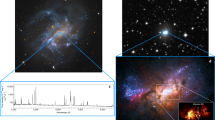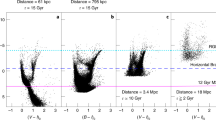Abstract
In recent years, new astronomical instruments have reversed three decades of fruitless searching for brown dwarfs, the failed stars that are too small to burn nuclear fuel. These discoveries have confirmed predictions about the importance of methane and dust in the atmospheres of brown dwarfs. But they also demonstrate that, contrary to expectation, brown dwarfs do not contribute significantly to our Galaxy's dark matter.
This is a preview of subscription content, access via your institution
Access options
Subscribe to this journal
Receive 51 print issues and online access
$199.00 per year
only $3.90 per issue
Buy this article
- Purchase on Springer Link
- Instant access to full article PDF
Prices may be subject to local taxes which are calculated during checkout

Similar content being viewed by others
References
Kumar, S. S. The structure of stars of very low mass. Astrophys. J. 137, 1121–1125 (1963).
Tarter, J. C. in Astrophysics of Brown Dwarfs (eds Kafatos, M. C., Harrington, R. S. & Maran, S. P.) 121–138 (Cambridge Univ. Press, (1986).
Laughlin, G., Adams, F. & Bodenheimer, P. in Very Low-mass Stars and Brown Dwarfs in Stellar Clusters and Associations (Cambridge Univ. Press, in the press).
Burrows, A., Hubbard, W. B. & Lunine, J. I. Theoretical models of very low mass stars and brown dwarfs. Astrophys. J. 345, 939– 958 (1989).
D'Antona, F. & Mazzitelli, I. New pre-main-sequence tracks for M less than or equal to 2.5 solar mass as tests of opacities and convection model. Astrophys. J. Suppl. Ser. 90, 467 –500 (1994).
Chabrier, G., Baraffe, I. & Plez, B. Mass-luminosity relationship and lithium depletion for very low mass stars. Astrophys. J. 459, L91–L94 (1996).
Freeman, K. in Unsolved Problems of the MIlky Way (eds Blitz, L. & Teuben, P.) 645–650 (IAU Symp. 169, Kluwer, Dordrecht, ( 1996).
Bodenheimer, P. in Brown Dwarfs and Extrasolar Planets (eds Rebolo, R., Martin, E. L. & Zapatero Osorio, M. R.) 115–127 (ASP Conf. Ser. 134, Astron. Soc. Pacific, San Francisco, (1998 ).
Reid, N. in The Bottom of the Main Sequence—And Beyond (ed. Tinney, C.) 53–62 (Springer, Heidelberg, (1995 ).
Henry, T. J. in Brown Dwarfs and Extrasolar Planets (eds Rebolo, R., Martin, E. L. & Zapatero Osorio, M. R.) 28–35 (ASP Conf. Ser. 134, Astron. Soc. Pacific, San Francisco, (1998).
Marcy, G. & Butler, R. P. Detection of extrasolar giant planets. Annu. Rev. Astron. Astrophys. 36, 56–96 (1998).
Hambly, N. in Brown Dwarfs and Extrasolar Planets (eds Rebolo, R., Martin, E. L. & Zapatero Osorio, M. R.) 11–19 (ASP Conf. Ser. 134, Astron. Soc. Pacific, San Francisco, (1998).
Bouvier, J. et al. Brown dwarfs and very low-mass stars in the Pleiades cluster: a deep wide-field imaging survey. Astron. Astrophys. 336, 490–502 (1998).
Stauffer, J., Schultz, G. & Kirkpatrick, J. D. Keck spectra of Pleiades brown dwarf candidates and a precise determination of the lithium depletion edge in the Pleiades. Astrophys. J. 499, L199–L203 (1998).
Skrutskie, M. F. et al. in The Impact of Large Scale Near-IR Sky Surveys (eds Garzón, F. et al.) 25–32 (Kluwer, Dordrecht, (1997).
Epchtein, N. in The Impact of Large Scale Near-IR Sky Surveys (eds Garzón, F. et al.) 15–24 (Kluwer, Dordrecht, ( 1997).
Kirkpatrick, J. D. et al. Brown dwarfs discovered by 2MASS and the definition of a new spectral type cooler than “M”. Bull. Am. Astron. Soc. 192, 5504–5504 ( 1998).
Tsuji, T., Ohnaka, K. & Aoki, W. in The Bottom of the Main Sequence—And Beyond (ed. Tinney, C.) 45–49 (Springer, Heidelberg, (1995).
Tsuji, T., Ohnaka, K. & Aoki, W. Dust formation in stellar photospheres: a case of very low mass stars and a possible resolution on the effective temperature scale of M dwarfs. Astron. Astrophys. 305, L1– L4 (1996).
Sharp, C. M. & Huebner, W. F. Molecular equilibrium with condensation. Astrophys. J. Suppl. Ser. 72, 417– 431 (1990).
Nakajima, I. et al. Discovery of a cool brown dwarf. Nature 378, 463–465 (1996).
Matthews, K. et al. Spectral energy distribution and bolometric luminosity of the cool brown dwarf Gliese 229B. Astron. J. 112, 1678–1682 (1996).
Allard, F., Hauschildt, P. H., Baraffe, I. & Chabrier, G. Synthetic spectra and mass determination of the brown dwarf GL229B. Astrophys. J. 465, L123–L127 (1996).
Oppenheimer, B. R., Kulkarni, S. R., Matthews, K. & Nakajima, T. Infrared spectrum of the cool brown dwarf G1229B. Science 270, 1478–1479 (1995).
Becklin, E. E. & Zuckerman, B. Alow-temperature companion to a white dwarf star. Nature 336, 656–658 (1988).
Tsuji, T., Ohnaka, K. & Aoki, W. Evolution of dusty photospheres through red to brown dwarfs: how dust forms in very low mass objects. Astron. Astrophys. 308, L29–L32 (1996).
Kirkpatrick, J. D. et al. An improved optical spectrum and new model fits for the likely brown dwarf GD 165B. Astrophys. J. (submitted).
Tinney, C. G., Mould, J. R. & Reid, I. N. The faintest stars—infrared photometry, spectra and bolometric magnitudes. Astron. J. 105, 1045–1059 (1993).
Ruiz, M. T., Leggett, S. K. & Allard, F. Kelu-1: a free-floating brown dwarf in the solar neighborhood. Astrophys. J. 491, L107– L110 (1997).
Delfosse, X. et al. Field brown dwarfs found by DENIS. Astron. Astrophys. 327, L25–L28 ( 1997).
Tinney, C. G., Delfosse, X. & Forveille, T. DENIS-P J1228.2-1547—a new benchmark brown dwarf. Astrophys. J. 490, L95– L98 (1997).
Martín, E. L., Basri, G., Delfosse, X. & Forveille, T. Keck HIRES spectra of the brown dwarf DENIS-P J1228.2-1547. Astron. Astrophys. 327, L29–L32 (1997).
Allard, F., Hauschildt, P., Alexander, D. R. & Starrfield, S. Annu. Rev. Astron. Astrophys. 35, 137– 178 (1997).
Tinney, C. G., Delfosse, X., Forveille, T. & Allard, F. Optical spectroscopy of DENIS mini-survey brown dwarf candidates. Astron. Astrophys. 338, 1066–1072 (1998).
Oppenheimer, B. R., Kulkarni, S. R., Matthews, K. & van Kerkwijk, M. The spectrum of the brown dwarf Gliese 229B. Astrophys. J. 502, 932–943 (1998).
Schultz, A. B. et al. First results from the space telescope imaging spectrograph: optical spectra of Gliese 229B. Astrophys. J. 492, L181–L184 (1998).
Burrows, A. & Sharp, C. M. Chemical equilibrium abundances in brown dwarf and extrasolar giant planet atmospheres. Astrophys. J. (submitted); also as preprint astro-ph/9807055 at 〈http://xxx.lanl.gov 〉 (1998).
Scalo, J. M. The stellar initial mass function. Fund. Cosmic Phys. 11, 1–278 (1986).
Reid, I. N. & Gizis, J. E. Low-mass binaries and the stellar luminosity function. Astron. J. 113, 2246 –2269 (1997).
Kroupa, P. in Brown Dwarfs and Extrasolar Planets (eds Rebolo, R., Martín, E. L. & Zapatero Osorio, M. R.) 483–494 (ASP Conf. Ser. 134, Astron. Soc. Pacific, San Francisco, (1998).
Tinney, C. G. The faintest stars: the luminosity and mass functions at the bottom of the main sequence. Astrophys. J. 445, 1017– 1018 (1995).
Adams, F. in Brown Dwarfs and Extrasolar Planets (eds Rebolo, R., Martín, E. L. & Zapatero Osorio, M. R.) 3–10 (ASP Conf. Ser. 134, Astron. Soc. Pacific, San Francisco, (1998).
Basri, G., Marcy, G. W. & Graham, R. J. Lithium in brown dwarf candidates: the mass and age of the faintest Pleiades stars. Astrophys. J. 458, 600–609 (1996).
Rebolo, R., Zapatero Osorio, M. R. & Martín, E. L. Discovery of a brown dwarf in the Pleiades star cluster. Nature 377, 129–131 (1995).
Magazzu, A., Martín, E. L. & Rebolo, R. Aspectroscopic test for substellar objects. Astrophys. J. 404, L17–L20 (1993).
Tinney, C. G. The intermediate-age brown dwarf LP944-20. Mon. Not. R. Astron. Soc. 296, L42–L44 ( 1998).
Thackrah, A., Jones, H. & Hawkins, M. Lithium detection in a field brown dwarf candidate. Mon. Not. R. Astron. Soc. 284, 507– 512 (1997).
Martín, E. L., Zapatero-Osorio, M. R. & Rebolo, R. in Brown Dwarfs and Extrasolar Planets (eds Rebolo, R., Martín, E. L. & Zapatero Osorio, M. R.) 507– 514 (ASP Conf. Ser. 134, Astron. Soc. Pacific, San Francisco, ( 1998).
Luhman, K. L. & Rieke, G. H. The low mass initial mass function in young clusters: L1495E. Astrophys. J. 497, 354–369 (1998).
Comeron, F., Rieke, G. H. & Rieke, M. J. Properties of low-mass objects in NGC2024. Astrophys. J. 473, 294–303 (1996).
Hambly, N. C., Steele, I. A., Hawkins, M. R. S. & Jameson, R. F. The very low-mass main sequence in the Galactic cluster Praesepe. Mon. Not. R. Astron. Soc. 273, 505– 512 (1995).
Williams, D. M., Rieke, G. H. & Stauffer, J. R. The stellar mass function of Praesepe. Astrophys. J. 445, 359–366 (1995).
Ashman, K. M. Dark matter in galaxies. Publ. Astron. Soc. Pacif. 104, 1109–1138 (1992).
King, I. R., Anderson, J., Cool, A. M. & Piotto, G. The luminosity function of the globular cluster NGC 6397 near the limit of hydrogen burning. Astrophys. J. 492, L37 –L40 (1998).
Piotto, G., Cool, A. M. & King, I. R. Acomparison of deep HST luminosity functions of four globular clusters. Astron. J. 113, 1345– 1352 (1997).
Pulone, L., De Marchi, G., Paresce, F. & Allard, F. The lower main sequence of omega Centauri from deep hubble space telescope NICMOS near-IR observations. Astrophys. J. 492, L41–L44 (1998).
Chabrier, G. & Mera, D. Determination of the globular cluster and halo stellar mass functions and stellar and brown dwarf densities. Astron. Astrophys. 328, 83–94 (1997).
Paczynski, B. Gravitational microlensing in the local group. Annu. Rev. Astron. Astrophys. 34, 419–460 ( 1996).
Alcock, C. et al. The MACHO project Large Magellanic Cloud microlensing reuslts from the first two years and the nature of the galactic dark halo. Astrophys. J. 486, 697–726 (1997).
Zaritsky, D. & Lin, D. N. C. Evidence for an intervening stellar population toward the Large Magellanic Cloud. Astron. J. 114, 2545–2555 (1997).
Alcock, C. et al. EROS and MACHO combined limits on planetary-mass dark matter in the Galactic halo. Astrophys. J. 499, L9–L12 (1998).
Acknowledgements
I thank J. Hawthorn, P. Butler and H. Sim for comments, and G. Chabrier, I. Baraffe, B. Openheimer&J. D. Kirkpatrick for material used in the figures.
Author information
Authors and Affiliations
Rights and permissions
About this article
Cite this article
Tinney, C. Brown dwarfs: the stars that failed. Nature 397, 37–40 (1999). https://doi.org/10.1038/16195
Issue Date:
DOI: https://doi.org/10.1038/16195
Comments
By submitting a comment you agree to abide by our Terms and Community Guidelines. If you find something abusive or that does not comply with our terms or guidelines please flag it as inappropriate.




